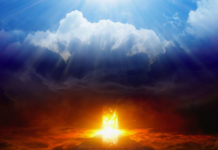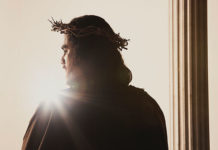by Michael Johnson
Give our readers a bit of historical context of illuminated Bibles.
As I began The Four Holy Gospels project, the lack of examples of contemporary visual language of illuminations became a significant obstacle. It is amazing, and rather disappointing, that no other artist has illumined the four Gospels for over 400 years! The only effort that comes close is The Saint John’s Bible project—a magnificent work of calligraphy and illustrations. But The Four Holy Gospels needed to be readable, i.e. accessible for both personal, everyday reading or in communal liturgy.
Barry Moser’s woodcuts, and William Blake, Marc Chagall, and Georges Rouault’s paintings each gave Biblical text and themes proper expression. But except for Blake’s art, these works do not illumine the Biblical text in the way that I envisioned for this project. Rather, they are allusions and separate images intended to function apart from the text. Typically, illustrations establish a one-to-one relationship with the text, thus it needs to amplify a particular element, or sentiment, of the story.
On the other hand, illuminations should not amplify the text as the Biblical text does not need amplification. Instead, the artist is first illumined by the text. What is then created is a result of worship, done in response to the illumined heart by the Biblical Word.
Many illuminated Bibles were created in medieval times. What’s the connection?
Despite the boundaries and the limitations given to an illuminator, the great illuminations of the medieval past create a generative, one-to-many relationship with the text. The images are theological, refractive interpretations, as well as giving visual aid to the viewer.
In medieval times, because of illiteracy, the images sometimes spoke of the specific theological, narrative elements of the Bible. I wanted to re-define illumination art, increasing both the legibility and accessibility, while also creating a dynamic relationship between the text and illuminations, dancing together for the glory of God.
Since The Four Holy Gospels commemorates the 400th anniversary of the King James Version Bible, why was the English Standard Version of the Bible used instead of the KJV?
First, I would have been very uncomfortable illuminating the KJV. It would be akin to illumining Shakespeare—why do it if the natural outcome of the written word has already been digested by the greater culture?
Secondly, the ESV is both a contemporary translation and faithful to the past. For a contemporary expression and visual language of mine, it proved an ideal ground to base my efforts upon.
What role did tradition play in creating The Four Holy Gospels?
Artists depend on other artists’ examples, helping inform the artist’s approach. While painting you are conversing, quoting (and some would say even “stealing”!) other works. Tradition is important because you need the past forms to inform the future expressions. So one can look at the Book of Kells and medieval illumined manuscripts, or commute to the Metropolitan Museum of Art, The Morgan Library and many other institutions. It makes a huge difference to see the works up close. Virtual images are, well, virtual, and for a trained eye. The tangible reality to behold in front of you cannot be replaced.
Next Thursday: Part Three—How Fujimura painted “Jesus Wept,” along with art excerpt.
Makoto Fujimura is an artist, writer, and founder of International Arts Movement. He has had over 100 exhibits worldwide, and from 2003-2009 was Presidentially appointed to the National Council on the Arts. An ordained elder (on sabbatical) at Redeemer Presbyterian Church, Mako and his wife, Judy, raised their three children in lower Manhattan.











